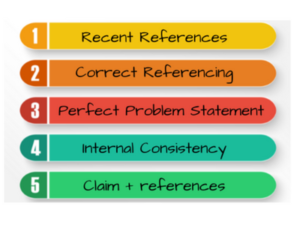
There are certain parts of a proposal, dissertation or thesis that often trip students up early on.
Let me share 5 of them with you (in no particular order).
First off, is the trap of outdated references.
The rule of thumb is that over 80% of your references should be newer than 5 years old (unless you’re researching a historical topic). It’s particularly serious when you cite an outdated reference and imply that it represents a current viewpoint.
A remedy is to specify a date range in your literature searches, e.g., 2018 onwards. Or find newer sources that reference an older article. Google Scholar provides these options, as do other search engines.
The second trap is sloppy referencing.
This is where in-text references are missing, or where in-text references don’t tie up with the reference list, and vice versa.
The remedy here is to use a referencing tool, e.g., Mendeley Cite, Zotero, or EndNote. With these, you can insert your in-text references correctly as you write, and avoid errors in your reference list. This will save you many unnecessary hours later.
The third trap is a poor Problem Statement.
Students often confound the various sections of the Introduction chapter. For example, they provide a Problem Statement of several pages that states the background of the problem at length without specifying the actual problem that needs to be researched.
A remedy for a good problem statement is to place it after the sections specifying the Background/Introduction, the Foreground/Research Problem, and the high-level debates in the Research Literature. Then the problem statement briefly summarises these three previous sections, and also states the knowledge gap and the rationale for your research. It does all this in a succinct paragraph of ½ – ⅔ of a page.
The fourth trap is internal inconsistency in your document.
Very often, the problem, research objectives/purpose of the research, and the research questions are not aligned, and so the document makes inconsistent promises.
A remedy is to review your own document and highlight every time you’ve said what the research is going to achieve. Then copy and paste these highlighted bits to a page, look for inconsistencies, and correct them. It will clear your thought processes too.
The fifth trap is focusing on who said what in your writing.
This is where each paragraph starts with the authors’ names and states what they say, or says, “According to ….”.
The remedy here is to focus on what is said, i.e., the claim, and then place the reference in brackets at the end of the claim, i.e., claim + references. This will uplift the conceptual level of your writing.
Would you like me to help you with your research methodology?
Contact [email protected]